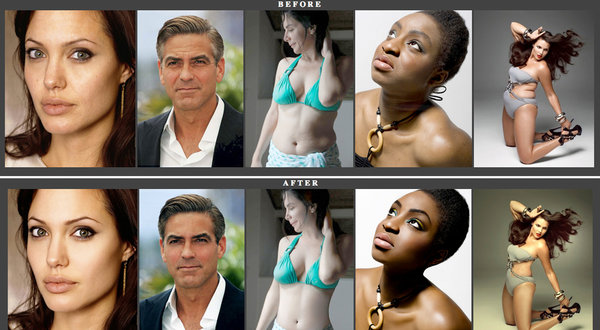by Sandy Hubbard, Print Futurist
Software to Rate How Drastically Photos Are Retouched
By STEVE LOHR
 The photographs of celebrities and models in fashion advertisements and magazines are routinely buffed with a helping of digital polish. The retouching can be slight — colors brightened, a stray hair put in place, a pimple healed. Or it can be drastic — shedding 10 or 20 pounds, adding a few inches in height and erasing all wrinkles and blemishes, done using Adobe’s Photoshop software, the photo retoucher’s magic wand.
The photographs of celebrities and models in fashion advertisements and magazines are routinely buffed with a helping of digital polish. The retouching can be slight — colors brightened, a stray hair put in place, a pimple healed. Or it can be drastic — shedding 10 or 20 pounds, adding a few inches in height and erasing all wrinkles and blemishes, done using Adobe’s Photoshop software, the photo retoucher’s magic wand.
“Fix one thing, then another and pretty soon you end up with Barbie,” said Hany Farid, a professor of computer science and a digital forensics expert at Dartmouth.
And that is a problem, feminist legislators in France, Britain and Norway say, and they want digitally altered photos to be labeled. In June, the American Medical Association adopted a policy on body image and advertising that urged advertisers and others to “discourage the altering of photographs in a manner that could promote unrealistic expectations of appropriate body image.”
Continues at: Software to Rate How Drastically Photos Are Retouched – NYTimes.com.
Related articles
- Software Identifies Photoshopping; Celebrities Look Shockingly Different [PHOTOS] (ibtimes.com)
- Photo Retouching in Advertising (mediawatchkevin.wordpress.com)
- Do Photoshopped Images Make You Feel Bad About Your Own Looks? (learning.blogs.nytimes.com)
- Retouching Reality: New Tool Detects When Images Have Been Photoshopped (newsfeed.time.com)
- Photo Retouching Detector of the Day (geeks.thedailywh.at)
- Retouching Reality: New Tool Detects When Images Are Photoshopped (newsfeed.time.com)
- Does Retouching Ruin Dove’s Message? (bellasugar.com)
- Exposed: Software reveals how much photos have been retouched (guardian.co.uk)
- This technology might soon tell us how much an image has been enhanced (thenextweb.com)












